| View previous topic :: View next topic |
| Author |
Message |
emperorjot

Joined: 07 Aug 2023
Posts: 11
|
 Posted: Mon Aug 07, 2023 1:11 pm Post subject: Mysterious Eastman Kodak Rochester NY Posted: Mon Aug 07, 2023 1:11 pm Post subject: Mysterious Eastman Kodak Rochester NY |
 |
|
emperorjot wrote:
I've just purchased a mysterious Kodak lens - described by the seller as a "1 inch Kodak Lens"
It has a maximum aperture of 6.8 and a minimum of 32. The only other engravings on the lens besides the aperture markings are "EASTMAN KODAK ROCHESTER NY." It hasn't been posted to me yet so I haven't been able to get a close look but do have the original seller's photos of it. I'm wondering if anyone can identify anything about it (especially its potential mount) so that I can understand its use better.
#1
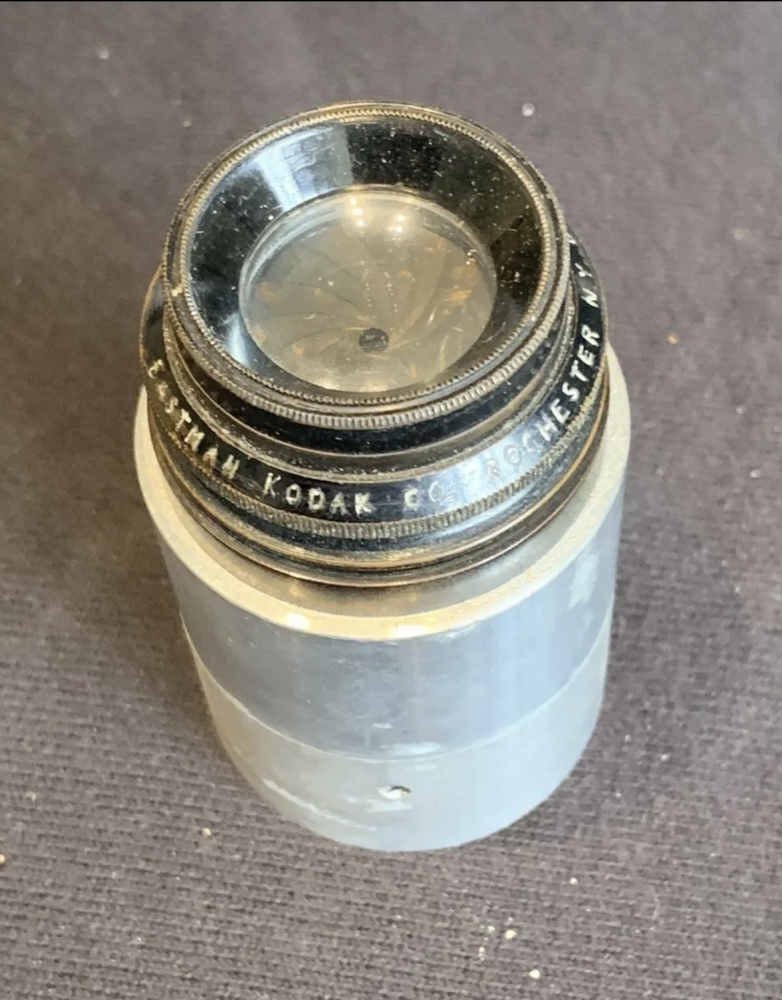
#2
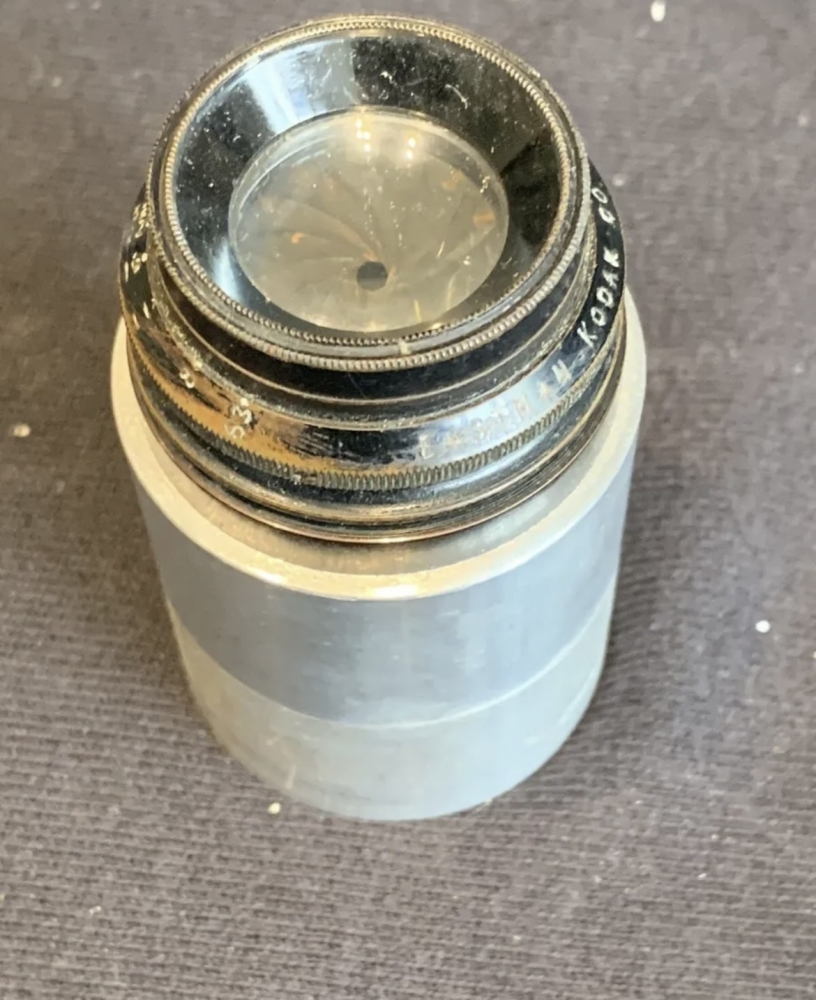
#3

#4
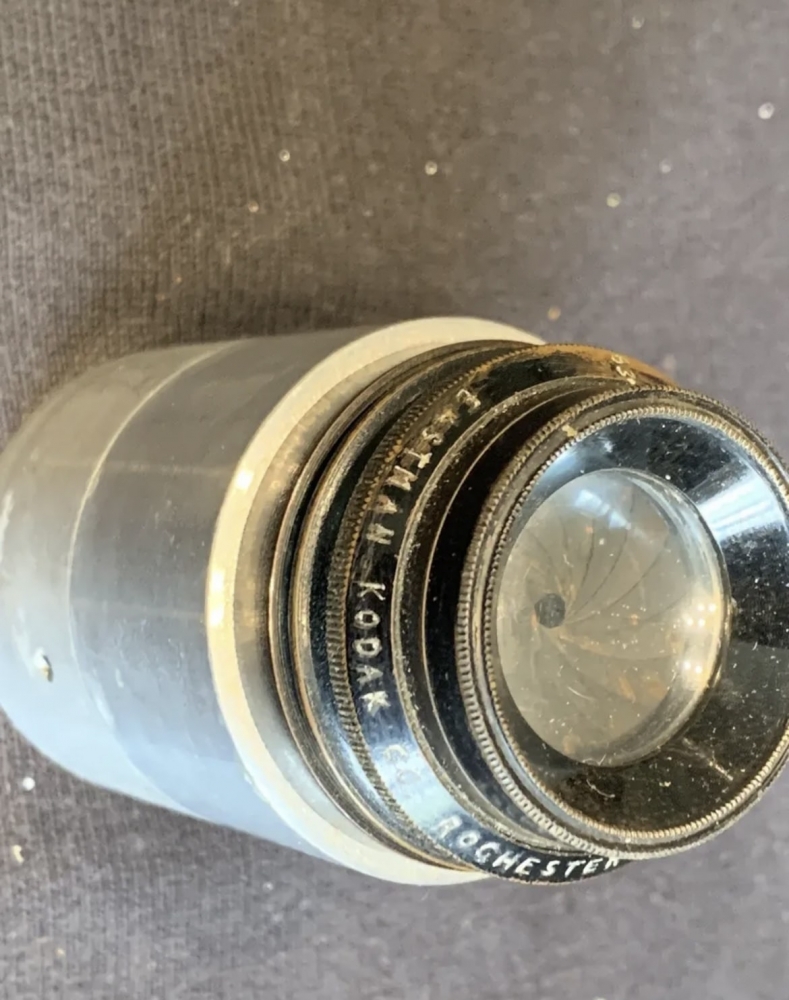
#5
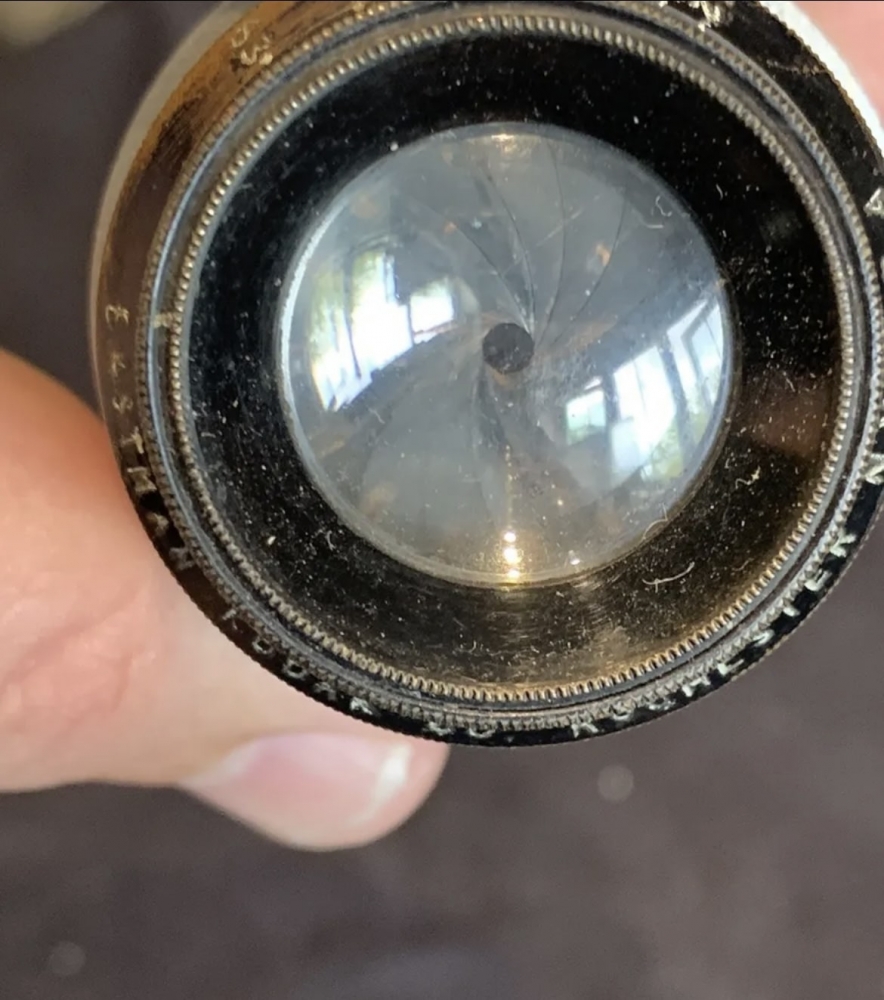
#6
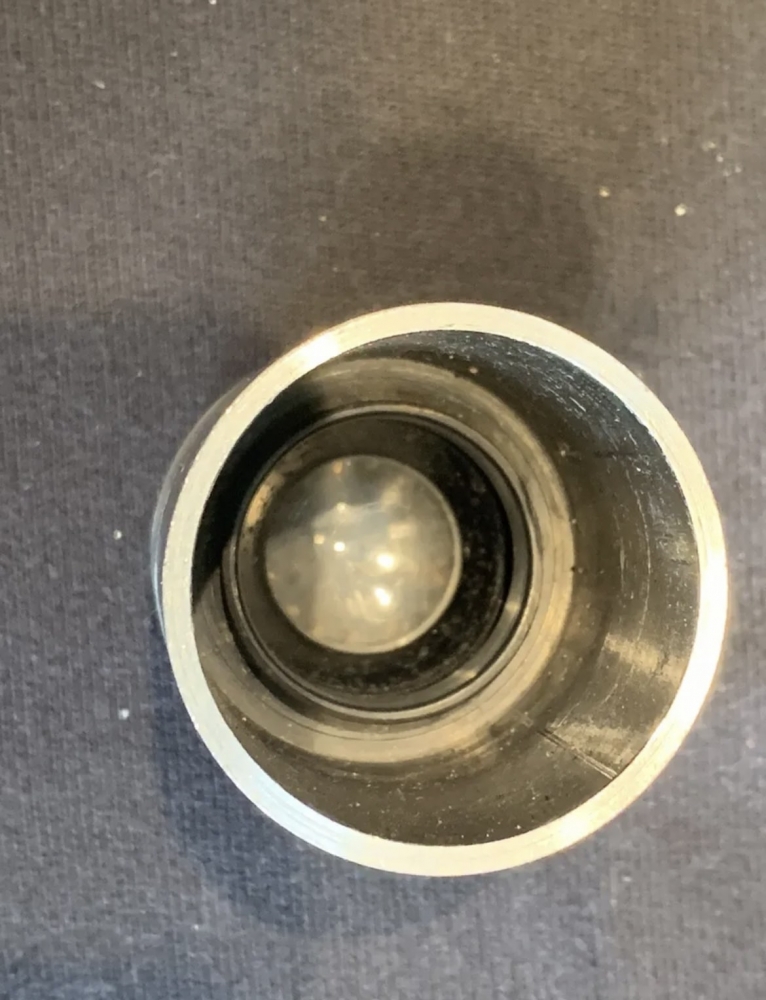
_________________
EJ |
|
| Back to top |
|
 |
blotafton


Joined: 08 Aug 2013
Posts: 1616
Location: Sweden
|
 Posted: Mon Aug 07, 2023 1:41 pm Post subject: Re: Mysterious Eastman Kodak Rochester NY Posted: Mon Aug 07, 2023 1:41 pm Post subject: Re: Mysterious Eastman Kodak Rochester NY |
 |
|
blotafton wrote:
| emperorjot wrote: |
I've just purchased a mysterious Kodak lens - described by the seller as a "1 inch Kodak Lens"
It has a maximum aperture of 6.8 and a minimum of 32. The only other engravings on the lens besides the aperture markings are "EASTMAN KODAK ROCHESTER NY." It hasn't been posted to me yet so I haven't been able to get a close look but do have the original seller's photos of it. I'm wondering if anyone can identify anything about it (especially its potential mount) so that I can understand its use better.
#1

#2

#3

#4

#5

#6
 |
|
|
| Back to top |
|
 |
Gatorengineer64

Joined: 26 Oct 2017
Posts: 283
|
 Posted: Mon Aug 07, 2023 9:15 pm Post subject: Posted: Mon Aug 07, 2023 9:15 pm Post subject: |
 |
|
Gatorengineer64 wrote:
thats an old Kodak enlarging lens.... not sure on the mount.....
_________________
A7R4, GFX50R and a bucket of mflenses |
|
| Back to top |
|
 |
emperorjot

Joined: 07 Aug 2023
Posts: 11
|
 Posted: Mon Aug 07, 2023 9:55 pm Post subject: Posted: Mon Aug 07, 2023 9:55 pm Post subject: |
 |
|
emperorjot wrote:
| Gatorengineer64 wrote: |
| thats an old Kodak enlarging lens.... not sure on the mount..... |
Interesting. If it's an enlarging lens does that mean that its description of 1 inch (or about a 25.4mm) focal length is incorrect considering it seems most enlarging lenses are of more telephoto focal lengths?
_________________
EJ |
|
| Back to top |
|
 |
jamaeolus


Joined: 19 Mar 2014
Posts: 2964
Location: Eugene
Expire: 2015-08-20
|
 Posted: Tue Aug 08, 2023 4:23 am Post subject: Posted: Tue Aug 08, 2023 4:23 am Post subject: |
 |
|
jamaeolus wrote:
I doubt the 1 inch is actually the FL. The lens seems too large for that.
_________________
photos are moments frozen in time |
|
| Back to top |
|
 |
calvin83


Joined: 12 Apr 2009
Posts: 7555
Location: Hong Kong
|
 Posted: Tue Aug 08, 2023 6:04 am Post subject: Posted: Tue Aug 08, 2023 6:04 am Post subject: |
 |
|
calvin83 wrote:
Never see a Kodak enlarging like this. You can check if it is an 1 inch lens if you have other 24-25mm for comparison.
_________________
https://lensfever.com/
https://www.instagram.com/_lens_fever/
The best lens is the one you have with you. |
|
| Back to top |
|
 |
emperorjot

Joined: 07 Aug 2023
Posts: 11
|
 Posted: Tue Aug 08, 2023 9:45 am Post subject: Posted: Tue Aug 08, 2023 9:45 am Post subject: |
 |
|
emperorjot wrote:
| jamaeolus wrote: |
| I doubt the 1 inch is actually the FL. The lens seems too large for that. |
Too large? Referring to the silver part of it?
_________________
EJ |
|
| Back to top |
|
 |
calvin83


Joined: 12 Apr 2009
Posts: 7555
Location: Hong Kong
|
 Posted: Tue Aug 08, 2023 12:11 pm Post subject: Posted: Tue Aug 08, 2023 12:11 pm Post subject: |
 |
|
calvin83 wrote:
I am pretty sure it is not a lens with focal length of 1 inch(25mm). It looks like it is a lens with focal length of 4 inch(100mm) or more.
_________________
https://lensfever.com/
https://www.instagram.com/_lens_fever/
The best lens is the one you have with you. |
|
| Back to top |
|
 |
jamaeolus


Joined: 19 Mar 2014
Posts: 2964
Location: Eugene
Expire: 2015-08-20
|
 Posted: Tue Aug 08, 2023 1:50 pm Post subject: Posted: Tue Aug 08, 2023 1:50 pm Post subject: |
 |
|
jamaeolus wrote:
I agree Calvin. Both the size of the elements compared to the hand and the size of the aluminum? tube indicate a much longer. FL. A 1inch enlarger lens is going to be pretty small. I have a Minolta CE 30mm that is much much smaller than that. Emperorjot? Please let us know what you discover. Looks interesting.
_________________
photos are moments frozen in time |
|
| Back to top |
|
 |
visualopsins


Joined: 05 Mar 2009
Posts: 10958
Location: California
Expire: 2025-04-11
|
 Posted: Tue Aug 08, 2023 3:26 pm Post subject: Posted: Tue Aug 08, 2023 3:26 pm Post subject: |
 |
|
visualopsins wrote:
I don't see any 1" mark?
Looks like lens that fits a shutter such as Comput. Similar to Retina lens.
_________________
☮☮☮☮☮☮☮☮☮☮☮☮☮☮☮☮☮☮☮☮☮☮☮☮☮☮☮☮☮☮☮☮ like attracts like! ☮☮☮☮☮☮☮☮☮☮☮☮☮☮☮☮☮☮☮☮☮☮☮☮☮☮☮☮☮☮☮☮
Cameras: Sony ILCE-7RM2, Spotmatics II, F, and ESII, Nikon P4
Lenses:
M42 Asahi Optical Co., Takumar 1:4 f=35mm, 1:2 f=58mm (Sonnar), 1:2.4 f=58mm (Heliar), 1:2.2 f=55mm (Gaussian), 1:2.8 f=105mm (Model I), 1:2.8/105 (Model II), 1:5.6/200, Tele-Takumar 1:5.6/200, 1:6.3/300, Macro-Takumar 1:4/50, Auto-Takumar 1:2.3 f=35, 1:1.8 f=55mm, 1:2.2 f=55mm, Super-TAKUMAR 1:3.5/28 (fat), 1:2/35 (Fat), 1:1.4/50 (8-element), Super-Multi-Coated Fisheye-TAKUMAR 1:4/17, Super-Multi-Coated TAKUMAR 1:4.5/20, 1:3.5/24, 1:3.5/28, 1:2/35, 1:3.5/35, 1:1.8/85, 1:1.9/85 1:2.8/105, 1:3.5/135, 1:2.5/135 (II), 1:4/150, 1:4/200, 1:4/300, 1:4.5/500, Super-Multi-Coated Macro-TAKUMAR 1:4/50, 1:4/100, Super-Multi-Coated Bellows-TAKUMAR 1:4/100, SMC TAKUMAR 1:1.4/50, 1:1.8/55
M42 Carl Zeiss Jena Flektogon 2.4/35
Contax Carl Zeiss Vario-Sonnar T* 28-70mm F3.5-4.5
Pentax K-mount SMC PENTAX-A ZOOM 1:3.5 35~105mm, SMC PENTAX ZOOM 1:4 45~125mm
Nikon Micro-NIKKOR-P-C Auto 1:3.5 f=55mm, NIKKOR-P Auto 105mm f/2.5 Pre-AI (Sonnar), Micro-NIKKOR 105mm 1:4 AI, NIKKOR AI-S 35-135mm f/3,5-4,5
Tamron SP 17mm f/3.5 (51B), Tamron SP 17mm f/3.5 (151B), SP 500mm f/8 (55BB), SP 70-210mm f/3.5 (19AH)
Vivitar 100mm 1:2.8 MC 1:1 Macro Telephoto (Kiron)
|
|
| Back to top |
|
 |
emperorjot

Joined: 07 Aug 2023
Posts: 11
|
 Posted: Thu Aug 10, 2023 10:32 am Post subject: Posted: Thu Aug 10, 2023 10:32 am Post subject: |
 |
|
emperorjot wrote:
| jamaeolus wrote: |
| I agree Calvin. Both the size of the elements compared to the hand and the size of the aluminum? tube indicate a much longer. FL. A 1inch enlarger lens is going to be pretty small. I have a Minolta CE 30mm that is much much smaller than that. Emperorjot? Please let us know what you discover. Looks interesting. |
When it arrives around this weekend I'll keep the thread updated. My big hopes right now are that it's not somehow permanently attached to the silver cylinder and that its focal length is somewhere around 100mm.
_________________
EJ |
|
| Back to top |
|
 |
emperorjot

Joined: 07 Aug 2023
Posts: 11
|
 Posted: Thu Aug 10, 2023 8:18 pm Post subject: Posted: Thu Aug 10, 2023 8:18 pm Post subject: |
 |
|
emperorjot wrote:
| visualopsins wrote: |
I don't see any 1" mark?
Looks like lens that fits a shutter such as Comput. Similar to Retina lens. |
I've done some digging and you're somewhat right it seems. The colours, design, and lack of focal length makes me think it could be from this family of Kodak Brownie No. 2A cameras.
#1
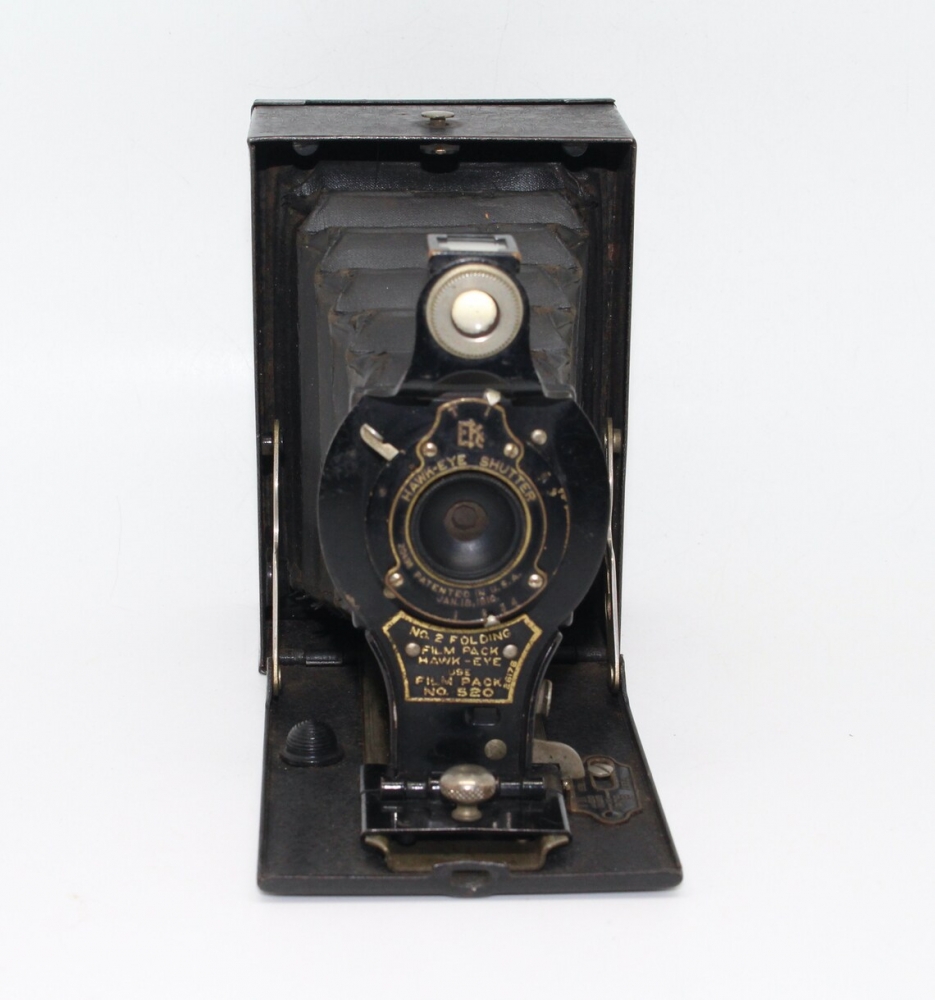
#2
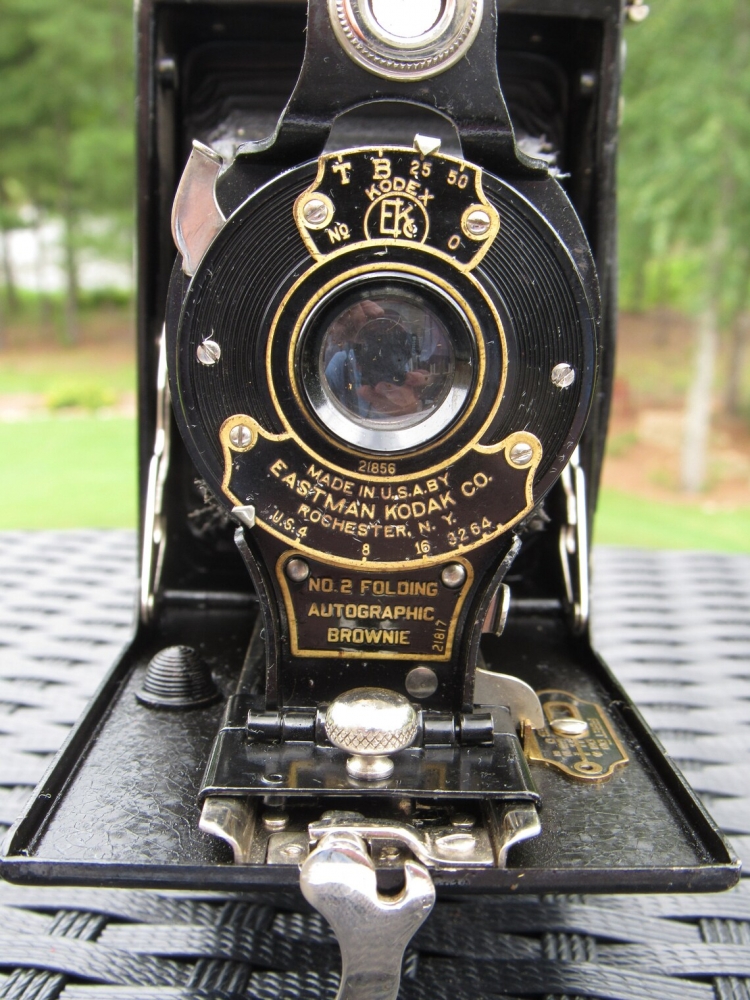
#3

_________________
EJ |
|
| Back to top |
|
 |
emperorjot

Joined: 07 Aug 2023
Posts: 11
|
 Posted: Thu Aug 10, 2023 8:22 pm Post subject: Posted: Thu Aug 10, 2023 8:22 pm Post subject: |
 |
|
emperorjot wrote:
| emperorjot wrote: |
| visualopsins wrote: |
I don't see any 1" mark?
Looks like lens that fits a shutter such as Comput. Similar to Retina lens. |
I've done some digging and you're somewhat right it seems. The colours, design, and lack of focal length makes me think it could be from this family of Kodak Brownie No. 2A cameras.
#1

#2

#3
 |
Or if it really is an enlarging lens as some suspect it to probably be then it could be from the same time period as this series of cameras.
_________________
EJ |
|
| Back to top |
|
 |
jamaeolus


Joined: 19 Mar 2014
Posts: 2964
Location: Eugene
Expire: 2015-08-20
|
 Posted: Thu Aug 10, 2023 9:52 pm Post subject: Posted: Thu Aug 10, 2023 9:52 pm Post subject: |
 |
|
jamaeolus wrote:
My guess is it is just threaded into the aluminum tube and the livery suggests (as you point out) early 20th century. Probably 1905 to 1925 range. There would almost no call for a 1 inch enlarger lens during this time frame. Your wish for 100mm-ish lens seems likely to come true. My experience with lenses from this era is that they are surprisingly good...if proper care is taken to accommodate their inherent weaknesses. Ie keep the main lighting behind you, use a deep hood and don't expect razor sharp corners. The flaws...coma, veiling flair, rainbow flair etc can be used for dramatic artistic effects. What kind of adaptation kit do you already own? Bellows? Helicoid adapter? Extension tubes? I have cobbled together quick easy testing systems and more complicated things as well. Quick tests can often be done by drilling a hole in a plastic body cap not quite big enough for the threads to drop through then judiciously carving it bigger until thr threads start to bite into the plastic. The work the lens back and forth to carve threads with the lens in the plastic (don't do this with a metal body cap!). Another approach is to actually use the aluminum tube as the inner part of a tube in tube sliding focus system. If you do this you will want to blacken the inside of the aluminum. Take it off the lens. Spray with flat black spray paint, or better yet apply stick on flocking vinyl.
_________________
photos are moments frozen in time |
|
| Back to top |
|
 |
emperorjot

Joined: 07 Aug 2023
Posts: 11
|
 Posted: Thu Aug 10, 2023 10:39 pm Post subject: Posted: Thu Aug 10, 2023 10:39 pm Post subject: |
 |
|
emperorjot wrote:
| jamaeolus wrote: |
| My guess is it is just threaded into the aluminum tube and the livery suggests (as you point out) early 20th century. Probably 1905 to 1925 range. There would almost no call for a 1 inch enlarger lens during this time frame. Your wish for 100mm-ish lens seems likely to come true. My experience with lenses from this era is that they are surprisingly good...if proper care is taken to accommodate their inherent weaknesses. Ie keep the main lighting behind you, use a deep hood and don't expect razor sharp corners. The flaws...coma, veiling flair, rainbow flair etc can be used for dramatic artistic effects. What kind of adaptation kit do you already own? Bellows? Helicoid adapter? Extension tubes? I have cobbled together quick easy testing systems and more complicated things as well. Quick tests can often be done by drilling a hole in a plastic body cap not quite big enough for the threads to drop through then judiciously carving it bigger until thr threads start to bite into the plastic. The work the lens back and forth to carve threads with the lens in the plastic (don't do this with a metal body cap!). Another approach is to actually use the aluminum tube as the inner part of a tube in tube sliding focus system. If you do this you will want to blacken the inside of the aluminum. Take it off the lens. Spray with flat black spray paint, or better yet apply stick on flocking vinyl. |
Right now the only vintage adapters I have are an m42 to e mount one so I'm unprepared for this type of lens. My instinct is to go to a helicoid adapter to allow myself to control the focus of the lens. The methods you described all sound pretty interesting though.
_________________
EJ |
|
| Back to top |
|
 |
jamaeolus


Joined: 19 Mar 2014
Posts: 2964
Location: Eugene
Expire: 2015-08-20
|
 Posted: Fri Aug 11, 2023 8:15 pm Post subject: Posted: Fri Aug 11, 2023 8:15 pm Post subject: |
 |
|
jamaeolus wrote:
Well, if the lens unscrews off the aluminum as I think, then you need to get to m42 with the proper threads and the proper distance to the sensor. Kodak might be imperial or metric, hard to say. Helicoid m42 to m42 are available in several ranges and are very helpful for this kind of project. They aren't horribly expensive but not dirt cheap either, thirtyish IIRC . The standard extension sets from China are dirt cheap 5 ish but the odds of hitting the right focal length without some type of variable system are quite small. For quick and dirty estimates I do "Free lensing" ie hold the lens up to the body of the camera, or the adapter, and see if you can get an image. Move the lens in and out until you get an image. This is easier if you have a tripod to mount the camera on. Also a dark piece of cloth over the top of camera and lens will help limit stray light from washing out the image. That way you can get a handle on what kind of tube length and adapter you might need. A permanent mount thread to thread in metal might be easy...or might not be possible for less money that you paid for the lens. There are lots and lots of ready made adapters from China or also more specialized ones from RAFcamera in Belarus, others exist as well but I have not purchased from any of them. Custom fabrication can be accomplished but depending on where you are that can get expensive. SKGrimes in the US is fantastic for professional photographers with unusual needs but would be pretty expensive for a hobbyist on a limited budget.
_________________
photos are moments frozen in time |
|
| Back to top |
|
 |
emperorjot

Joined: 07 Aug 2023
Posts: 11
|
 Posted: Mon Aug 14, 2023 4:35 pm Post subject: Posted: Mon Aug 14, 2023 4:35 pm Post subject: |
 |
|
emperorjot wrote:
| jamaeolus wrote: |
| Well, if the lens unscrews off the aluminum as I think, then you need to get to m42 with the proper threads and the proper distance to the sensor. Kodak might be imperial or metric, hard to say. Helicoid m42 to m42 are available in several ranges and are very helpful for this kind of project. They aren't horribly expensive but not dirt cheap either, thirtyish IIRC . The standard extension sets from China are dirt cheap 5 ish but the odds of hitting the right focal length without some type of variable system are quite small. For quick and dirty estimates I do "Free lensing" ie hold the lens up to the body of the camera, or the adapter, and see if you can get an image. Move the lens in and out until you get an image. This is easier if you have a tripod to mount the camera on. Also a dark piece of cloth over the top of camera and lens will help limit stray light from washing out the image. That way you can get a handle on what kind of tube length and adapter you might need. A permanent mount thread to thread in metal might be easy...or might not be possible for less money that you paid for the lens. There are lots and lots of ready made adapters from China or also more specialized ones from RAFcamera in Belarus, others exist as well but I have not purchased from any of them. Custom fabrication can be accomplished but depending on where you are that can get expensive. SKGrimes in the US is fantastic for professional photographers with unusual needs but would be pretty expensive for a hobbyist on a limited budget. |
So the lens has arrived and I have a few revelations:
-The lens does unscrew from the silver cylinder it's mounted to. They definitely seem to be made for each other since some of the same brass material from the lens can be found on the cylinder.
-The lens itself works really well - the aperture is mostly smooth and after cleaning it the glass is almost completely scratch free (only one or two) and pretty clear.
-The mount of the lens is far smaller than my M42 to E mount adapter so I have to find a far smaller screw mount adapter if I want this to work.
-On the bottom of the lens (previously hidden inside the cylinder) is far more information about the make of the lens. It reads "KODAK PROJECTION ANASTIGMAT F6.3 51/4 IN NO 761" So it has an approximate focal length of 134mm.
#1
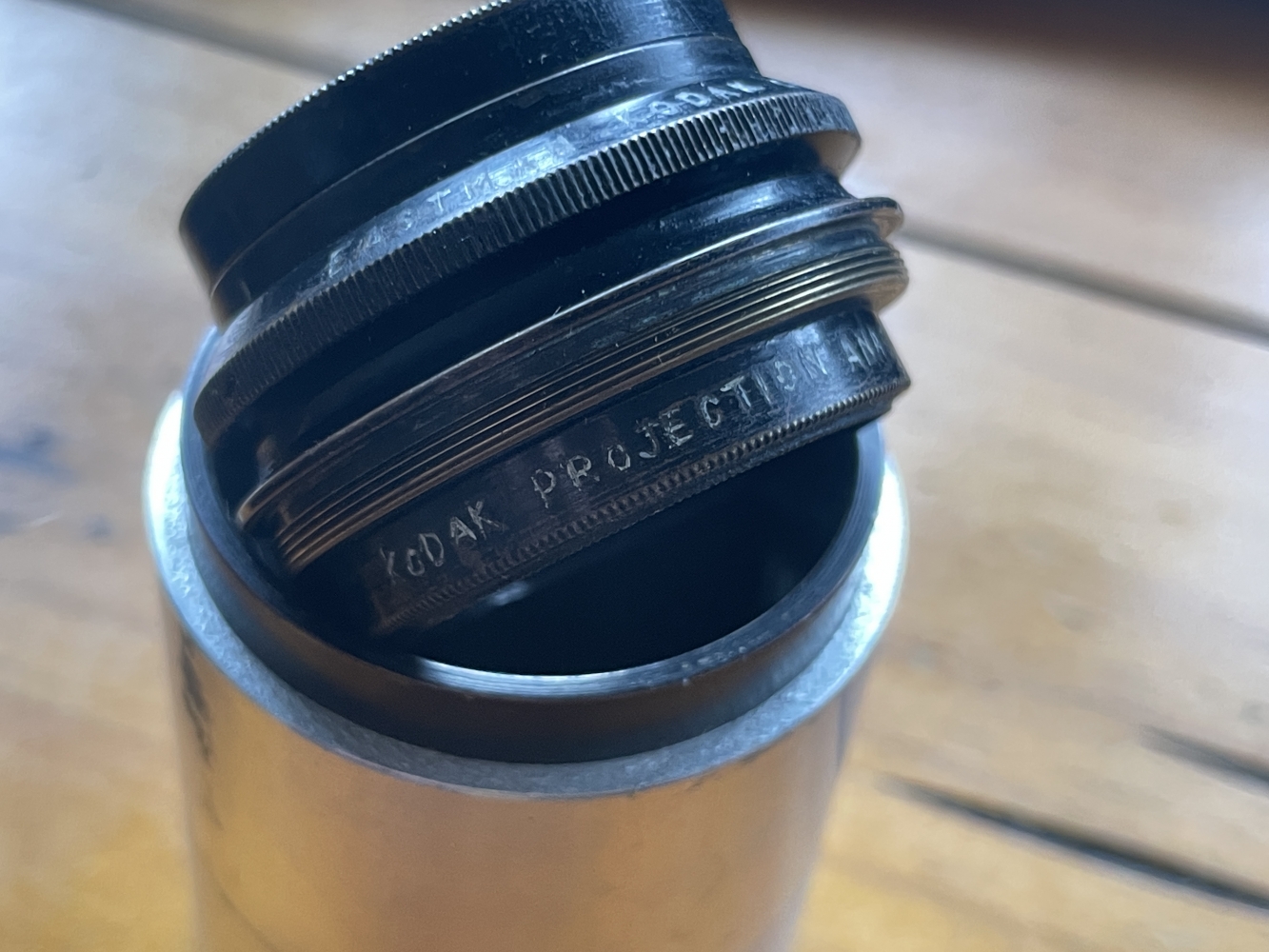
#2
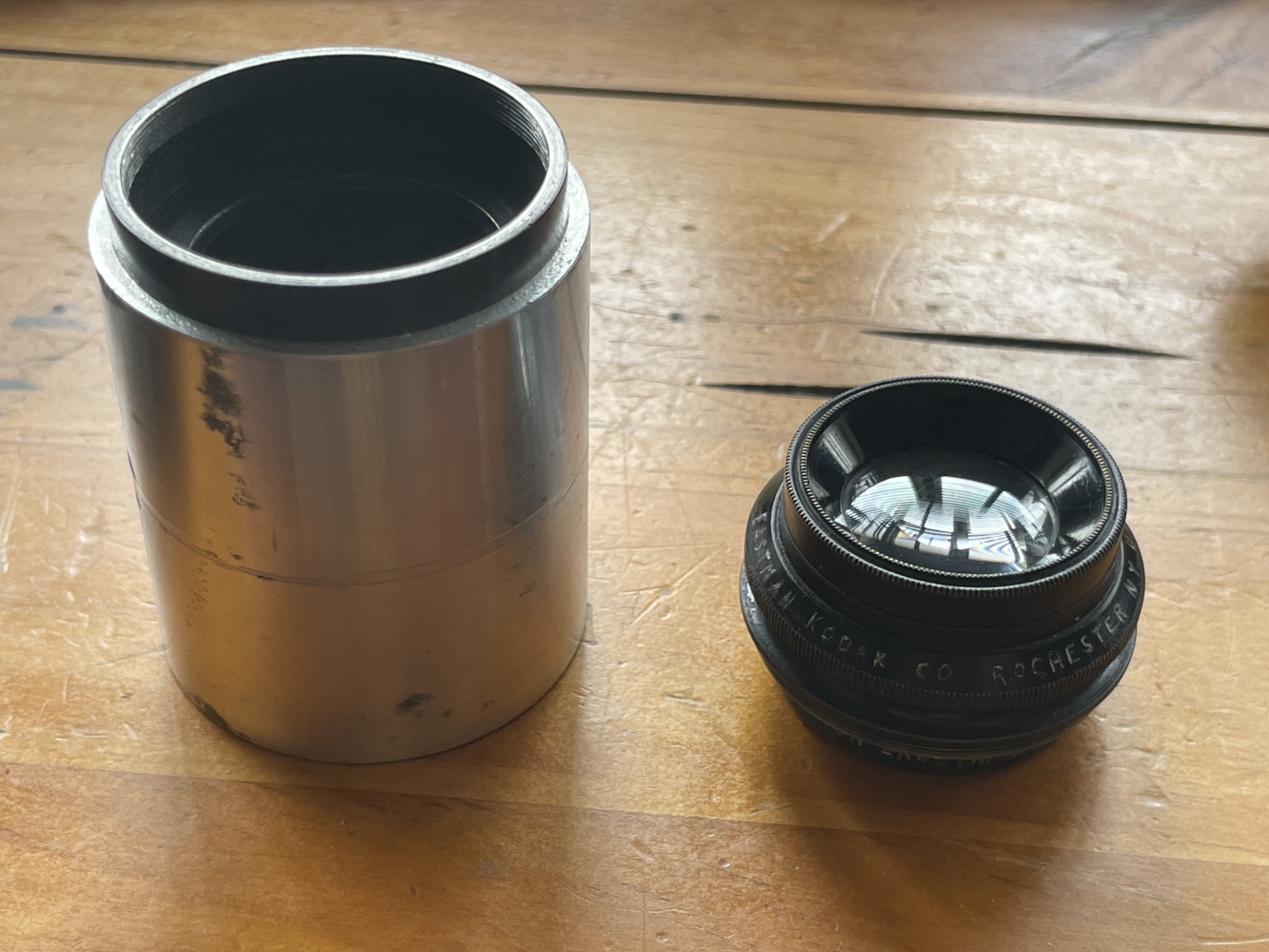
#3

#4

#5
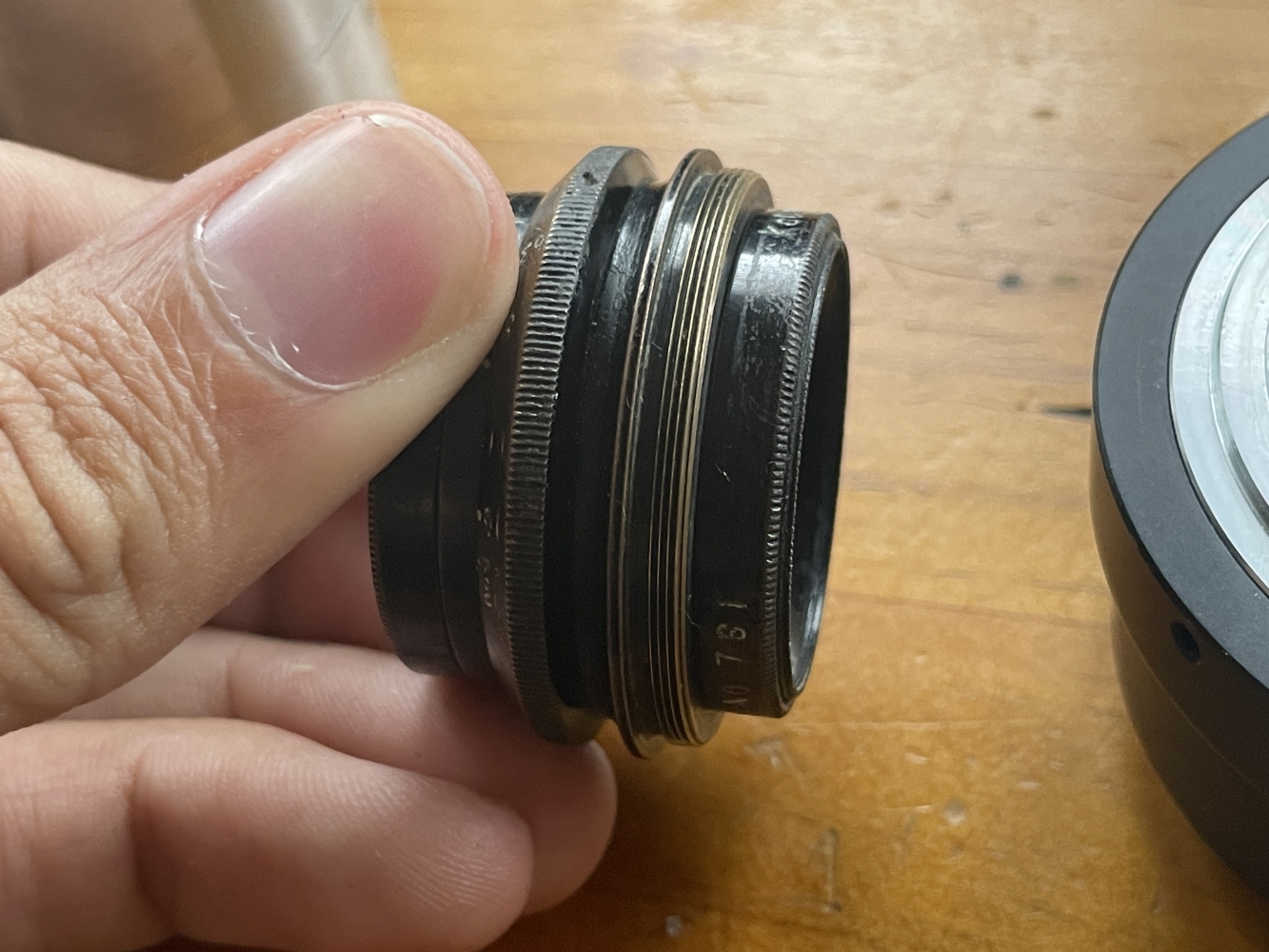
_________________
EJ |
|
| Back to top |
|
 |
alex ph

Joined: 16 Mar 2013
Posts: 1662
|
 Posted: Mon Aug 14, 2023 10:08 pm Post subject: Posted: Mon Aug 14, 2023 10:08 pm Post subject: |
 |
|
alex ph wrote:
Congrats for an interesting find!
It looks like a good enlarger lens. As for Kodak folder lenses, you may find some recent samples here and here. And here is a more modern enlarger lens than yours. It would be interesting to compare.
If you wish to test it ASAP, you might wish to use duct tape with an M42 adapter. |
|
| Back to top |
|
 |
jamaeolus


Joined: 19 Mar 2014
Posts: 2964
Location: Eugene
Expire: 2015-08-20
|
 Posted: Mon Aug 14, 2023 11:23 pm Post subject: Posted: Mon Aug 14, 2023 11:23 pm Post subject: |
 |
|
jamaeolus wrote:
Excellent! The first thing I would try is freelensing it with the aluminum tube attached. The 130 is FL means that from the center of the lens, (where the light crosses the aperture) to the sensor is 130 ish millimeters. That should have the lens focused at infinity. The first thing I would try is freelensing it with the aluminum tube attached. First just against the camera body. Hold the base of the aluminum tune tight against the lens mount (be careful not to hit the sensor if the aluminum tube diameter is small enough to actually fit inside the mount) See how that looks on the view screen. Change where the lens is pointed to distant and not so distant objects. If you have a distance that you form a sharp image then you need to do this without the aluminum tube. Repeat this against your m42 adapter if it is blurry. That will almost certainly be far enough out to create an image at some non infinity distance. Once youu have established that you need to mount the lens somewhere near that distance from the sensor.The body cap technique should be pretty easy. Purchase an m42 body cap. Plastic is easiest to start with. Cut a hole just a bit smaller than the diameter of the threads. Carve the edges slowly out until you can just get the threads to bite then work it back. And forth to use the brass lens threads to form threads in the plastic. Tighten it so the lens is flush all the way around the cap. Now with you m42 adapter and an m42 helicoid adapter and maybe an extension tube or 2 you can use it like a typical camera objective!
_________________
photos are moments frozen in time |
|
| Back to top |
|
 |
emperorjot

Joined: 07 Aug 2023
Posts: 11
|
 Posted: Tue Aug 15, 2023 11:54 am Post subject: Posted: Tue Aug 15, 2023 11:54 am Post subject: |
 |
|
emperorjot wrote:
| jamaeolus wrote: |
| Excellent! The first thing I would try is freelensing it with the aluminum tube attached. The 130 is FL means that from the center of the lens, (where the light crosses the aperture) to the sensor is 130 ish millimeters. That should have the lens focused at infinity. The first thing I would try is freelensing it with the aluminum tube attached. First just against the camera body. Hold the base of the aluminum tune tight against the lens mount (be careful not to hit the sensor if the aluminum tube diameter is small enough to actually fit inside the mount) See how that looks on the view screen. Change where the lens is pointed to distant and not so distant objects. If you have a distance that you form a sharp image then you need to do this without the aluminum tube. Repeat this against your m42 adapter if it is blurry. That will almost certainly be far enough out to create an image at some non infinity distance. Once youu have established that you need to mount the lens somewhere near that distance from the sensor.The body cap technique should be pretty easy. Purchase an m42 body cap. Plastic is easiest to start with. Cut a hole just a bit smaller than the diameter of the threads. Carve the edges slowly out until you can just get the threads to bite then work it back. And forth to use the brass lens threads to form threads in the plastic. Tighten it so the lens is flush all the way around the cap. Now with you m42 adapter and an m42 helicoid adapter and maybe an extension tube or 2 you can use it like a typical camera objective! |
Would an M42 to M42 helicoid adapter like this be suitable? Or at least something in this style? The one in the attached photos extends from 17mm to 31mm.
#1
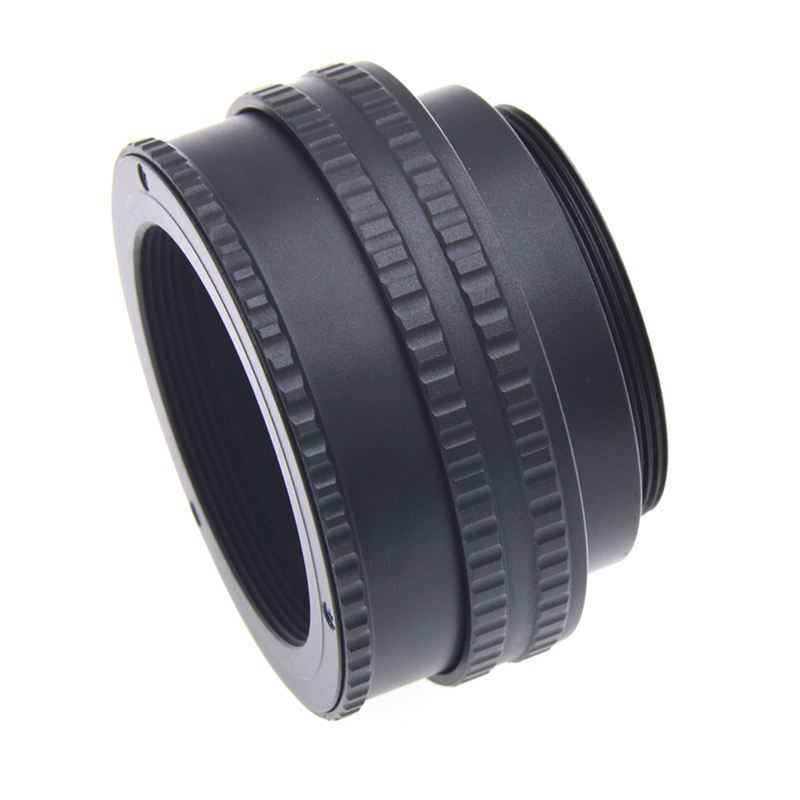
#2
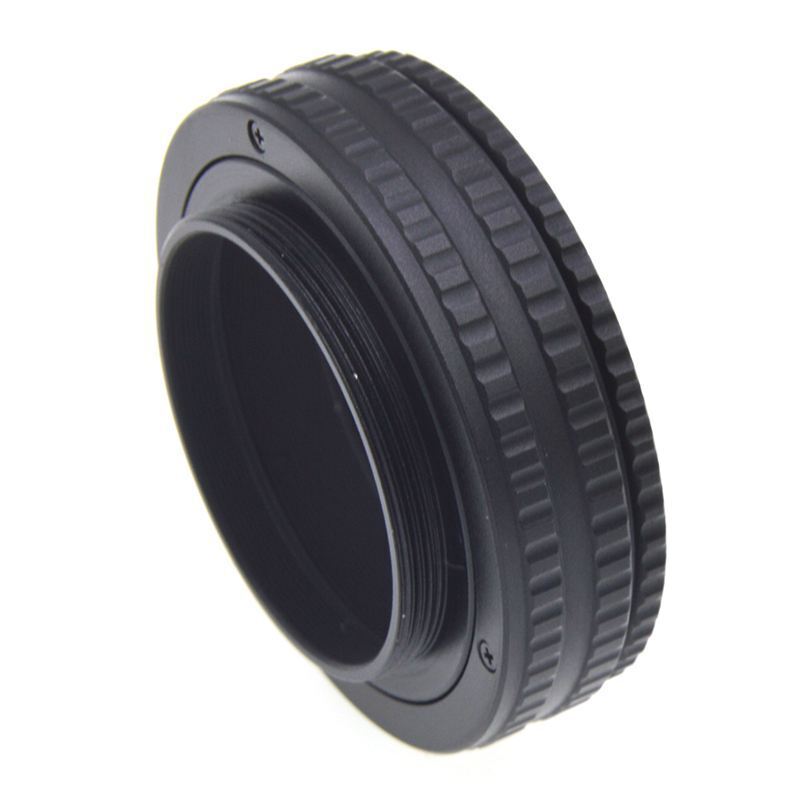
_________________
EJ |
|
| Back to top |
|
 |
jamaeolus


Joined: 19 Mar 2014
Posts: 2964
Location: Eugene
Expire: 2015-08-20
|
 Posted: Tue Aug 15, 2023 11:06 pm Post subject: Posted: Tue Aug 15, 2023 11:06 pm Post subject: |
 |
|
jamaeolus wrote:
Yes! That is just the kind of thing I was talking about. The trick will be to get enough extension that as the helicoid moves from 17 toward 31 it reaches infinity with a small movement. That is best but not always achievable. That ves the most fcal range for your custom lens. Getting to "the best you can" requires some trial and error which is why I suggested the freelensing experiments.
_________________
photos are moments frozen in time |
|
| Back to top |
|
 |
emperorjot

Joined: 07 Aug 2023
Posts: 11
|
 Posted: Mon Aug 21, 2023 12:35 am Post subject: Posted: Mon Aug 21, 2023 12:35 am Post subject: |
 |
|
emperorjot wrote:
| jamaeolus wrote: |
| Yes! That is just the kind of thing I was talking about. The trick will be to get enough extension that as the helicoid moves from 17 toward 31 it reaches infinity with a small movement. That is best but not always achievable. That ves the most fcal range for your custom lens. Getting to "the best you can" requires some trial and error which is why I suggested the freelensing experiments. |
I have a question about the focus helicoid - I understand that to reach infinity focus you need to put the middle of the lens element at its focal length away from the sensor. However what about the minimum focus? Is the minimum focal distance dependent on the minimum extension of the helicoid?
_________________
EJ |
|
| Back to top |
|
 |
calvin83


Joined: 12 Apr 2009
Posts: 7555
Location: Hong Kong
|
 Posted: Mon Aug 21, 2023 1:23 am Post subject: Posted: Mon Aug 21, 2023 1:23 am Post subject: |
 |
|
calvin83 wrote:
| emperorjot wrote: |
| jamaeolus wrote: |
| Yes! That is just the kind of thing I was talking about. The trick will be to get enough extension that as the helicoid moves from 17 toward 31 it reaches infinity with a small movement. That is best but not always achievable. That ves the most fcal range for your custom lens. Getting to "the best you can" requires some trial and error which is why I suggested the freelensing experiments. |
I have a question about the focus helicoid - I understand that to reach infinity focus you need to put the middle of the lens element at its focal length away from the sensor. However what about the minimum focus? Is the minimum focal distance dependent on the minimum extension of the helicoid? |
MFD dependent on the MAX extension of the helicoid.
_________________
https://lensfever.com/
https://www.instagram.com/_lens_fever/
The best lens is the one you have with you. |
|
| Back to top |
|
 |
emperorjot

Joined: 07 Aug 2023
Posts: 11
|
 Posted: Mon Aug 21, 2023 12:04 pm Post subject: Posted: Mon Aug 21, 2023 12:04 pm Post subject: |
 |
|
emperorjot wrote:
| calvin83 wrote: |
| emperorjot wrote: |
| jamaeolus wrote: |
| Yes! That is just the kind of thing I was talking about. The trick will be to get enough extension that as the helicoid moves from 17 toward 31 it reaches infinity with a small movement. That is best but not always achievable. That ves the most fcal range for your custom lens. Getting to "the best you can" requires some trial and error which is why I suggested the freelensing experiments. |
I have a question about the focus helicoid - I understand that to reach infinity focus you need to put the middle of the lens element at its focal length away from the sensor. However what about the minimum focus? Is the minimum focal distance dependent on the minimum extension of the helicoid? |
MFD dependent on the MAX extension of the helicoid. |
So to get the lens to focus to infinity I'd need to extend it to 133mm and to extend its close focus I'd need to extend it beyond that?
_________________
EJ |
|
| Back to top |
|
 |
calvin83


Joined: 12 Apr 2009
Posts: 7555
Location: Hong Kong
|
 Posted: Mon Aug 21, 2023 12:40 pm Post subject: Posted: Mon Aug 21, 2023 12:40 pm Post subject: |
 |
|
calvin83 wrote:
| emperorjot wrote: |
| calvin83 wrote: |
| emperorjot wrote: |
| jamaeolus wrote: |
| Yes! That is just the kind of thing I was talking about. The trick will be to get enough extension that as the helicoid moves from 17 toward 31 it reaches infinity with a small movement. That is best but not always achievable. That ves the most fcal range for your custom lens. Getting to "the best you can" requires some trial and error which is why I suggested the freelensing experiments. |
I have a question about the focus helicoid - I understand that to reach infinity focus you need to put the middle of the lens element at its focal length away from the sensor. However what about the minimum focus? Is the minimum focal distance dependent on the minimum extension of the helicoid? |
MFD dependent on the MAX extension of the helicoid. |
So to get the lens to focus to infinity I'd need to extend it to 133mm and to extend its close focus I'd need to extend it beyond that? |
The extension will be less than 133mm to focus to infinity. You need to check how much extension is needed to archive infinity. You need more extension to focus close.
_________________
https://lensfever.com/
https://www.instagram.com/_lens_fever/
The best lens is the one you have with you. |
|
| Back to top |
|
 |
|
|
